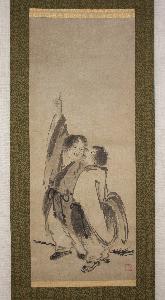Duzhan Xingying
Duzhan Xingying;Dokutan Shōkei
สถานที่: Putian
เกิด: 1628
ความตาย: 1706
ชีวประวัติ:
Duzhan Xingying, also known as Dokutan Shōkei, was a Chinese monk born in Putian, China in 1628. He was a significant figure in the spread of Zen Buddhism and was a disciple of Ingen Ryūki, who founded the Ōbaku school of Zen Buddhism in Japan.
Early Life and Career
Dokutan Shōkei was known for practicing the teachings of both Zen and Pure Land sects. He came to be known in Japan as Nenbutsu Dokutan or 'Dokutan who recites the Nenbutsu', which involves the repetition of the name of Amida. As a calligrapher, he is known for works such as the Chinese Poem to Celebrate a Senior Monk’s Sixtieth Birthday.
Artistic Style and Influences
Duzhan Xingying's artistic style was influenced by the Zen art movement, which emphasizes meditation, intuition, and simplicity. His works reflect the Zen belief in the importance of direct experience and the rejection of superfluous ornamentation. The Nihonga movement, a traditional style of Japanese painting that uses mineral pigments and organic materials on silk or paper, also had an impact on his art.
Notable Works and Legacy
Some notable works by Duzhan Xingying can be found on Wikioo.org, including Landscape with Pavilion. His legacy continues to inspire artists and collectors worldwide, with his works featured in museums such as the Boston Museum of Fine Arts and the Metropolitan Museum of Art. Key aspects of Duzhan Xingying's life and art include:
- His practice of both Zen and Pure Land sects
- His influence on the spread of Zen Buddhism in Japan
- His artistic style, which reflects the Zen emphasis on simplicity and direct experience
Duzhan Xingying died in 1706, but his art and legacy continue to be celebrated. For more information on his life and works, visit Wikioo.org or check out the Wikipedia page on Zen Buddhism.



